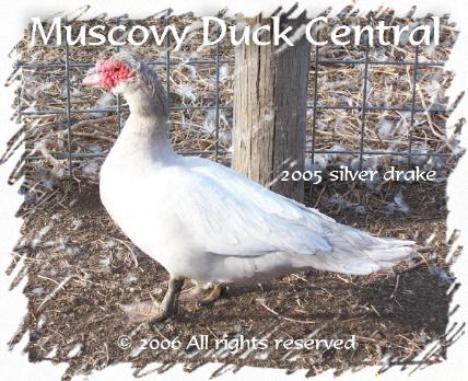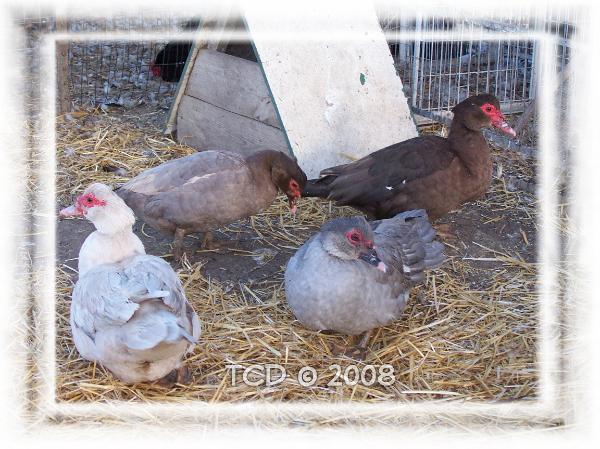Okay, I'm going to completely throw you off and say we have two FEMALES that are questionable, not a male. Sorry. That would make it easier.
How does the buff color breed true then?
How do Buff mallard-dev. ducks breed true?
I'm not sure I understand your questions, but I'll try.
If you want to know if a female is Buff (alone or in combination with Blue or Lavender), you can breed her to a male Buff. If she has sons that are Buff, then she must be Buff. If her sons are not Buff, then she is not Buff.
If she is Blue-Buff, then you will see two different colors in the offspring -- Buff and Blue-Buff. If all the offspring look the same, then she isn't Blue-Buff.
Here's the tricky part. If she's Lavender-Buff, and you breed her to a Buff male, all the offspring will be the same as well. HOWEVER, they will all be Blue-Buff, and in that case, none of the offspring would look like either parent (they'd be lighter than Dad and darker than Mom).
The Buff color breeds true because Buff X Buff = 100% Buff.
In Mallards, there are two different things someone could be talking about when he/she mentions "Buff." There is a gene called Buff, which is sex-linked recessive (just like Buff in geese) that changes black pigment to medium brown. A bird with regular Mallard pattern plus the Buff gene will simply have medium brown in place of black on the normal Mallard pattern. The Buff gene breeds true -- Buff X Buff = 100% Buff.
But then there's also a color-pattern combination called Buff (as seen in Orpingtons, Calls and Runners), which does include the Buff gene, but also includes several other genes (recessive Dusky, dominant Sooty, and incompletely dominant Blue) that result in more uniformly Buff-colored bird. The other genes affect the spread of black over the body, then the Blue and Buff genes dilute it.
Buff color-pattern may not breed true, depending on the description of the ideal "Buff" color. Some standards (in the UK) prefer a darker-colored Buff, which is caused by the duck having only one copy of the Blue gene. These Buffs (color-pattern) will not breed true -- Buff color-pattern X Buff color-pattern = 50% Buff color-pattern, 25% lighter Buff color-pattern, 25% brownish-Buff color-pattern. The reason you don't get all Buff color-pattern is the same reason Blue X Blue doesn't give all Blue -- the color results from birds with one copy of the gene, and when you breed two birds like this together, some offspring get two copies, some get no copies, and half get one copy.
Other standards (in the US) prefer the lighter colored Buff, and these birds have two copies of the Blue gene, thus they breed true.
As an aside, I can understand the confusion that comes up with regards to poultry genetics. People give a name to how a bird looks, irrespective of the genes that make it up. In other words, when you look at a Buff Orpington, there's nothing in the name that informs you as to what genes give the ducks that color pattern. I come from the cage-bird world. Most colors and patterns there are named after the genes or combinations of genes that make them up, and there is a standardization of gene names across species. In other words, a cockatiel showing Pied, Pearl, Cinnamon and Whiteface is called a "Cinnamon Pearl Pied Whiteface" rather than some unique name like "Cappuccino Swirl." And when a sex-linked brown dilution appears in another species, it is again called Cinnamon, and not some brand new unrelated name. This way, breeders can see patterns across species, and if someone knows how to make a Blue-Cinnamon budgie, they'll know it's the same thing in a Monk parakeet, and a Ring-necked parakeet, and a Parrotlet, and a Yellow Naped
Amazon, etc. because the same genes that are inherited the same way are given the same names in all those species.
In poultry, the names are dictated by the SOP for the breed, and then it's up to the breeders to translate that into the genes that make it happen -- and many times, the same appearance is given totally different names when it is found in different breeds. Very confusing -- it's almost as if the system is designed to make it harder for people to understand how to get the right combination of genes to satisfy the SOP.









